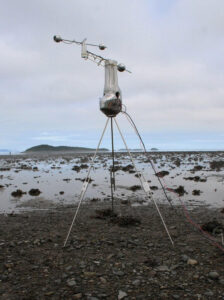
The Exhibition

Pascal Dufaux, Probe at Low Tide, 2014,
digital photograph on fabric paper. Courtesy of the artist
This exhibition takes as its starting point the modern fascination with the wilderness landscape, its status as a source of inspiration, a site of self-assertion, and an object of awe and dread. Looking at the work of six contemporary Canadian artists who address the use of the human figure in landscape imagery, it demonstrates how figuration of and within the natural world has changed. As European Romantic artists and writers of the 19th and 20th centuries celebrated the landscape as a source of personal and cultural renewal, parallel imperatives of control and extraction have revealed our notion of the “empty” wilderness as an exploitative fiction. In this context, especially poignant in the vastness of Canada, the land, and our relationship to it, appears uncertain. In the work of Moncton-based Mathieu Léger, contemporary positional and surveying technologies meet in a performative project that measures the artist’s movements against landscapes such as the Tablelands of western Newfoundland, where the duration of geological time is most visible. Edmonton artist Adam Waldron-Blain quotes and parodies the Romantic tradition of self-insertion (and self-assertion) in the wilderness, in clumsy musical performances, recorded on video, in which the artist’s feeble attempts at self-expression are overwhelmed by the natural environment. Newfoundland artist Will Gill documents his movements in the stark landscape of Svalbard, the world’s northernmost inhabited place. Wearing a light reflective suit that enhances his visibility in low light conditions while concealing his identity, the artist seems to occupy a rudimentary post-apocalyptic glacial world, hardly a utopian vision of self-renewal. Montreal-based Pascal Dufaux addresses the technological basis of our relationship to our environment-our media landscape-in an installation that transforms our movements in space into a feedback loop of scrambled information. Tanya Busse has been exploring, with an activist bent, human intervention within the landscape, in video works that document the deep mines and underground tunnels of the North. Robo She leads us through the inner workings of the Bjørnevatn separator plant in Norway, exploring their figurative resemblance to bodily processes and interior anatomy. And Jin-me Yoon has, following a career of exploring the implications of Canadian landscape imagery on the politics of identity, enacted a more phenomenological engagement with the natural world. In her recent photo series This time being, Yoon substitutes her own image with a surrogate object, “posed” within natural settings near her home on Hornby Island, British Columbia. The works explore a relationship with nature based on materiality rather than selfhood or identity, a corrective to the relations of power and control that have dominated the history of the landscape imaginary in Canada.
-Pan Wendt, Curator



 About the Centre
About the Centre Support the Centre
Support the Centre Art Gallery
Art Gallery Arts Education
Arts Education Heritage
Heritage On Stage
On Stage